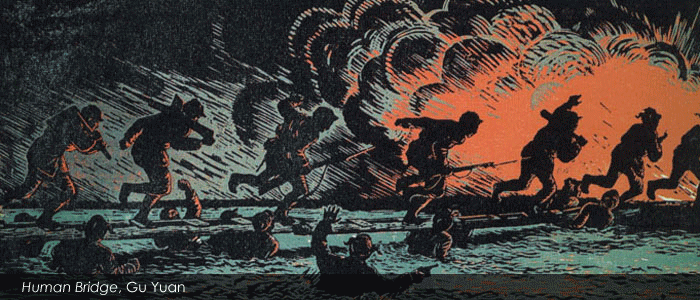

February 6 - May 24, 1998 | Guggenheim Museum SoHo |
1071 Fifth Avenue | New York, NY 10128-0173 | USA
July 18 - October 25, 1998 | Guggenheim Museum Bilbao |
Avenida Abandoibarra, 2 | Bilbao 48001 | Spain
Text and content information provided by Dr. Julia Andrews and Kuiyi Shen.
Symposium:
Conflict and Consensus in Twentieth-Century Chinese Art
Saturday, May 23
10:00 a.m. - 6:00 p.m.
The Peter B. Lewis Theater
The Sackler Center for Arts Education
Solomon R. Guggenheim Museum
1071 Fifth Avenue (at 89th Street)
Morning Session:
What Made Modern Chinese Art Modern?
- Modernism and Modernity in Late Nineteenth-Century Shanghai Painting
Jonathan Hay, Associate Professor of Art History
Institute of Fine Arts, New York University - Art at the Crossroads: Traditional Painters and Advertising Artists in Twentieth-Century Shanghai
Ellen Johnston Laing, Research Associate
Center for Chinese Studies, University of Michigan - China Roars: The Rise and Fall of the Avante-Garde Woodcut Movement
Julia Andrews, Associate Professor of the History of Art
The Ohio State University
and Kuiyi Shen, Visiting Professor of Art History
Rice University
Discussant: Richard Vinograd, Chair, Department of Art, Stanford University
Afternoon Session:
From Modernism to Communism
- China's Seduction by the West: The New Learning and Modern Painting
May-ching Kao, Professor of Fine Arts and Director, Art Museum,
The Chinese University of Hong Kong - China's Modernist Moment: Shanghai in the 1930s
Ralph Croizier, Professor of History
University of Victoria - The Art of New China in the World: A Neuropyschological Perspective
John Onians, Director, Program in World Art Research Program,
The University of East Anglia, and Assistant Director, Research and Academic Programs, Clark Art Institute
Discussant: Robert Harrist, Associate Professor of Art History and Archaeology, Columbia University
- The Red Guard and Post-Mao Painting
John Lebold Cohen, Research Associate, Fairbank Center, Harvard University, Author and Curator, New York - The Winking Owl Once More: Thick Description and the Vagaries of Visual Perception in and after the Cultural Revolution
Eugene Yuejin Wang, Assistant Professor of Fine Arts
Department of Fine Arts, Harvard University
Discussant: Sheng Tian Zheng, Director, Art Beatus Gallery
- The Traditionalism of the Avant-Garde: Early Fifth-Generation Cinema in Art-Historical Context
Jerome Silbergeld, Professor of Art
History, University of Washington
Discussant: Sheng Tian Zheng, Director, Art Beatus Gallery
Introduction to the Exhibition
Between 1850 and the present day, China's historic civilization has undergone a series of shocks and transformations that may be unprecedented in her history. This exhibition explores the ways its artists defined modernity and their own tradition against the complex background of China's recent history. This history included, in the nineteenth century, domestic rebellions, foreign invasions, and the establishment of treaty ports, and in the twentieth century, overthrow of the imperial system, urban industrialization, conquest by Japan, civil war, the Communist revolution, the Great Proletarian Cultural Revolution, and finally China's recent opening in commerce and culture to the international community.
A key issue for modern Chinese art is the degree to which Chinese artists have chosen to adopt Western conventions and the degree to which they have rejected them. Equally legitimate positions have been taken by artists whose work actively opposes the legacy of the past and by those who pursue innovations based upon their understanding of the Chinese tradition. The process of modernizing China's society during the past 150 years has created an art world in which ink painting (guohua) and oil painting are equally important component parts of the evolving mainstream of Chinese art. Modern Chinese art, in all its manifestations, may be seen as a conceptual and stylistic continuum of individual works that share web-like relationships to the culture of China's past and to those of a global present.
The exhibition is organized around four of the most compelling of the multiple realities that Chinese artists have constructed for themselves over the past century and a half. Moving roughly chronologically, the exhibition begins on the first floor with Innovations in Chinese Painting, 1850-1950. The second floor opens with radical experiments in Western media in The Modernist Generations, 1920-1950; moves next to the development of socialist realism in Art for New China, 1950-1980; and concludes with Transformations of Tradition, 1980-the Present, an examination of current trends.
